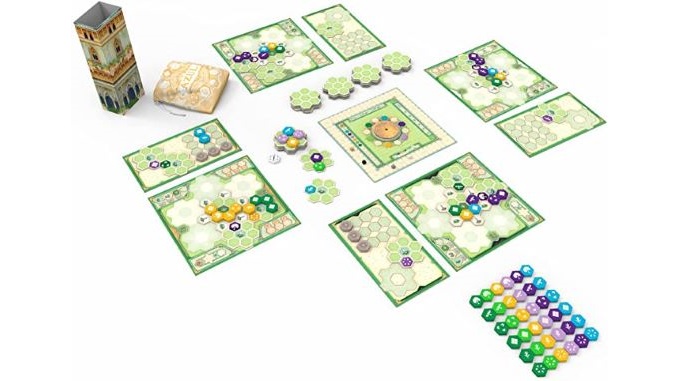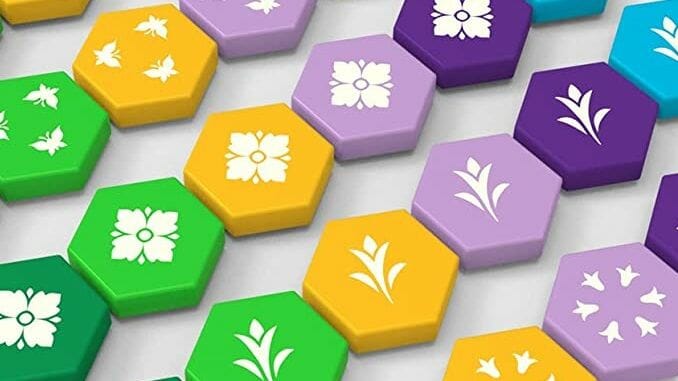Azul was my #1 game of 2017, winning the Spiel des Jahres award that year and spawning a whole series of sequels that has now reached four with the release of Azul: Queen’s Garden, the most complex Azul title yet. It’s another solid midweight game, but at this point we’ve gotten so far from the mechanics of the original that the only real connection is in the name.
Players in Azul: Queen’s Garden are once again taking and placing tiles on their personal boards, but this time, they’re also going to build out their boards as the game progresses. Also new to the Azul games is the use of patterns on tiles in game play, rather than just as ornamentation (although, once again, Azul is inaccessible to color-blind players). There are six colors and six patterns on the tiles, 36 such combinations, with three of each in the supply for each game. Players will place those tiles on the board to try to build chains of tiles that have the same color but different patterns or the same pattern but different colors, scoring certain tiles in each round but gaining the bigger point totals at game-end.
Unlike earlier iterations of Azul, Queen’s Garden starts each round with just four tiles available for the first player, and after each turn (with rare exception), four more are revealed until all of the new board pieces for that round have been removed from the stack—five for a two-player game, seven for three players, eight for four players. A player must take all tiles of a single color from the table, or all tiles of a single pattern, leaving any duplicate tiles. Once all tiles have been removed from a garden piece, it is flipped over, revealing the tile that is printed on its open side. That board piece is now treated as a tile in the selection phase; a player who takes all tiles of that color or pattern must take any matching garden pieces as well. Players have storage areas that can hold up to 12 tiles and two garden pieces. If they can’t store everything they might take from the board, they can’t take that action at all.

Placing tiles or garden pieces on boards is a separate action, and by far the most needlessly fiddly part of the game. Each pattern has a value from one to six, loosely represented by the artwork, which reflects both the tile’s point value at game-end and the cost to place it on a player’s board. To place a single tile with value six, showing six bluebells on it, you must discard five other tiles that all match the tile’s color or match its pattern, but none of those tiles can be identical to each other or the tile you’re placing. Since there are just six colors and six patterns, placing one bluebell tile is the hardest action in the game: you have to collect and then discard bluebell tiles in all five other colors, or collect tiles in that same color with each of the five other patterns. There are wild tokens, called jokers, that you can use to make up some of the gap here; each player starts with three, and can gain more by encircling any of the special features printed on the starting garden piece or any of the additional ones you add as the game goes along. Without those, playing enough of the highest-value tiles to create chains of three or more for final scoring would probably be impossible.
At the end of each of the four rounds, players score for each of three tile types on their boards, with those three types varying by round. Players may then choose to discard any unwanted tiles or garden pieces, paying their value by deducting points from their total. The final scoring is far more significant, as players score their groups of three or more tiles for each of the six colors and each of the six patterns, which is rather time-consuming. For color groups, players score the value of each tile in the group based on the pattern, one for the tree, two for the bird, and up to six for the bluebells. For pattern groups, it’s simply the number of tiles in the group times the value of the pattern. Any chain of the maximum size of six tiles (one pattern in all six colors or one color in all six patterns) gets a six-point bonus, so the most valuable possible chain, six bluebell tiles in all colors, is worth 42 points—but getting there is extremely difficult. It’s more significant in the way it boosts the value of color groups and the lower-value pattern groups, which are much easier to finish.
One of the most appealing aspects of the original Azul is the simplicity of its rules: You can explain it to a new player in five minutes, and while it takes a few plays to grasp the proper strategy or learn how best to count tiles to avoid a big penalty, there’s a low barrier to entry. The rules in each subsequent Azul title have been a bit more complicated than its predecessor, and each has resembled the original a little bit less. By this point, the similarity is merely thematic—Azul: Queen’s Garden is just not the same game as Azul in any essential way. And I think that’s a bigger issue than even the game’s fiddly tile-placement rules. If people buy Azul: Queen’s Garden expecting another Azul, they’re going to be a little disappointed, between the higher barrier to entry and the more onerous scoring phase at the end of the game. That’s not to say that Queen’s Garden is bad; in fact, it’s still quite good, and we found the game hums along pretty quickly once you get the rhythm of tile placement down, with our second two-player game taking maybe 45 minutes at most. I’d just like to see folks knowing what they’re getting when they shell out for the product.
Keith Law is the author of The Inside Game and Smart Baseball and a senior baseball writer for The Athletic. You can find his personal blog the dish, covering games, literature, and more, at meadowparty.com/blog.

